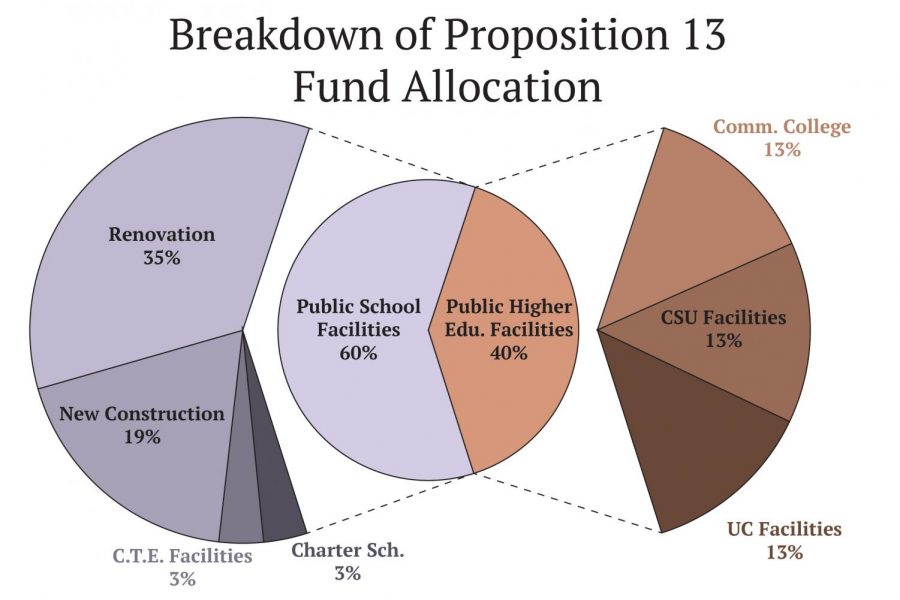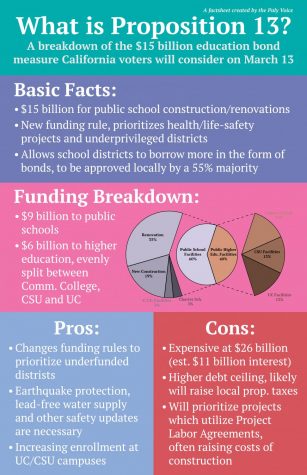Opinion: Proposition 13: A $15 billion bond to resuscitate California schools
March 1, 2020

On Tuesday, California voters will consider Proposition 13, which will sell $15 billion in state bonds to fund public K-12 schools, community colleges, California State University and University of California campuses.
A majority of the funds, $9 billion, will be spent on public school facilities. Of that sum, $5.2 billion will be spent on renovations, and $2.8 billion will be spent on new construction. An additional $6 billion will be evenly split between community college, CSU and UC facilities.
What is Proposition 13?

Despite all of the attention the Proposition has received because of its name, the Proposition 13 that voters will consider this primary election has no connection to the iconic Proposition 13 passed in 1978 which slashed property taxes. In fact, this March’s Proposition will likely do just the opposite. The measure will allow school districts to sell more bonds — to be approved by 55% of local voters — which will increase property taxes for certain communities.
The California Legislative Analyst’s Office estimates that borrowing $15 billion in the form of bonds will cost $11 billion in interest, racking up a price tag of $26 billion.
Perhaps the most monumental change is that this Proposition 13 will modify the way state funds are allocated. Currently, funds are distributing on a first-come, first-serve approach which generally favors wealthier districts as they’re able to apply for funding faster, according to a report by public policy specialists Eric Brunner from the University of Connecticut and Jeff Vincent from the University of California, Berkeley. Under Proposition 13, health and life-safety projects will receive the highest priority for state-level funding, followed by districts that struggle to raise funds locally. High priority will also be granted to water-safety projects and districts that have an agreement to use unionized labor.
Why you should vote yes
With the 2020 Democratic Primary long underway, progressive candidates are gaining significant traction. Given that many leading candidates already support policies such as free or inexpensive higher education and expanding public healthcare, what makes funding for public education so controversial for California democrats?
Especially when the measure prioritizes funding underprivileged school districts — some of which don’t even have clean drinking water — a “yes” vote sings to that same tune. After all, how can we be outraged by lead-contaminated drinking water in Flint, Michigan, but turn a blind eye to lead contamination in our schools’ drinking water? Regardless of the presidential election results in November, we can still promote progressive legislation locally.
In Palo Alto, we’re fortunate enough to enjoy cutting-edge facilities — a new $40 million gym, a newly-renovated college and career center and library and an upcoming science building expansion. Millions of students elsewhere in California are nowhere near as fortunate as us, and they deserve an equal opportunity to succeed.
Even if that’s a vision only possible in some faraway utopia, renovating California’s crumbling facilities is the first step in the right direction. Modern facilities not only foster a successful learning environment but also provide access to resources and new opportunities. Look no further than the Media Arts Center as an example, where students can learn anything from journalism to graphic design to photography, or the arts building, where students can learn to sculpt, draw and even blow glass. Proposition 13 will help to bridge such inequalities.
The Howard Jarvis Taxpayers Association organized the most prominent opposition to the measure. The Association primarily argues that the Propsoition costs too much, and cites concerns that the burden would primarily be placed on local taxpayers. While this may be true for some areas, it’s ultimately up to local voters whether or not to approve . Opening up the option for districts to borrow more is good, as it offers much-needed flexibility. Districts that don’t need additional funding simply won’t vote to raise taxes.
The $26 billion cost — $15 billion in principle and $11 billion in interest — is a hefty price tag, but worth it. The landmark changes the Proposition brings — the prioritization of underfunded districts — will last long after the last penny of the bonds are repaid.
In addition, the campaign has criticized the prioritization of projects that utilize organized labor.
“Additionally, this ‘Proposition 13’ needlessly raises the cost of school construction projects by giving priority for funding to districts that agree to use a Project Labor Agreement, or PLA,” the Association’s fact sheet states. “These agreements limit competitive bidding and require districts to pay the very highest labor costs in the area. This is an inefficient use of taxpayer dollars.”
The clause in the measure that favors projects which utilize union labor can be attributed to the large union constituency in the California Legislature, according to an article by the Los Angeles Times. But it’s merely a footnote in the Proposition’s massive triumph.
If California voters reject Proposition 13 because of a minor imperfection that’ll probably ride on any construction funding measure, we’ll probably be waiting around forever for that perfect piece of legislation, and our schools can’t wait. It’s now or never.



EmmieJ • Mar 2, 2020 at 3:52 am
As an alum and someone who is working on the campaign to get this measure passed, I appreciate your endorsement of Prop 13. Go Vikes! Reach out if you ever want to learn more about getting involved in campaigns like this. -Emmie Johnson (Class of ’97)
Lisa Henry • Mar 1, 2020 at 9:15 pm
This article is full of lies! It is ridiculous. Please do not be fooled, it will take away the no more than 2% raise on property taxes per year. If that happens California is done! The people will be sorry. All we hear about is money going to schools and that never happens. Do not fall for tha!!!